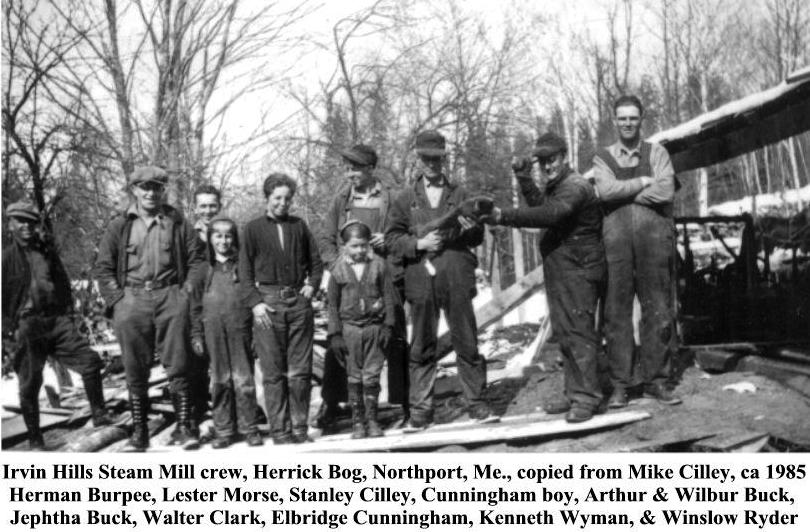Waldo
County, Maine Gen Web Site
Growing up
in Northport’s ‘Back Settlement’
by Isabel Morse Maresh
Originally published in
The Republican Journal of 7 Mar. 1996
Northport, Maine turned
200 years old in 1996. In the 1907 Town Register Northport was described as the
106th town in the State of Maine, was originally part of the
Plantation of Ducktrap. It is almost twenty-five square miles. In
The Town Register, 1907,
was written, “The surface is rough and broken by many hills, but there is much
good land for farming and about one half of the town is used for that purpose.
The coast line is irregular, and there is but one important harbor, Saturday
Cove. Northport is a noted summer resort and hundreds of visitors come in the
hot season to the Northport Camp Ground, Temple Heights and Saturday Cove. The
climate, like that of other towns on the bay is very healthful. The scenery is
varied and beautiful.”
In the earliest of census
records, Northport also had what was called the ‘Back settlement’, which
bordered on Belfast, Lincolnville, the Bay, and Belmont. The upper part of
Northport which was bounded by Belmont was called ‘The Panhandle’. The back
settlement, behind the hills which faced the Bay, was nearly forgotten about in
histories, with not much being written about. I grew up in the back settlement,
near Pitcher Pond. The names in the neighborhood on the 1859 map were Hurd,
Pitcher, Knowles, Clark, Brainard, Wadlin, Ware, Stevens, Goodell, Hart and
Farrow.
An article in the
Belfast City Press in 1887 was headlined ‘A Healthy and Desirable Location’,
which reads: “We have in the town of Northport four men whose united ages are
318 years, as follows: Amos Pitcher, 76, John Hurd, 81, Benjamin Stevens, 85 and
James Clark, 76. They all live in the same school district and on adjoining
farms. All have occupied their farms for more than sixty years, and all in full
possession of their mental faculties. Each is living with his youngest son, the
latter being worthy men, married to estimable women who are ambitious to make
home pleasant.
“They were all loyal to
their country in its hour of peril, always voting men and money to carry on the
War and contributing liberally in their private capacities. Messrs. Hurd and
Pitcher each gave their country a son. Young Hurd fell on the bloody field of
Shiloh, and young Pitcher died in the hospital near Washington, D.C. Messrs.
Hurd and Clark and their estimable wives are members of the Farmer’s Pride
Grange [in upper neighboring Lincolnville], although Mr. Hurd, by reason of
decrepitude, is unable to attend its meetings, while Mr. Clark, being younger is
quite a constant attendant and takes a lively interest in its meetings.
 |
“Messrs. Pitcher,
Stevens and Clark were born in Northport, Mr. Hurd came here shortly
after arriving at majority. Mr. Pitcher took his farm from his father,
Lewis Pitcher, who settled on it more than a hundred years ago. Mr.
Pitcher married Harriet Hills, Mr. Clark married Ruth Heal, Mr. Hurd
married Lydia Griffin, all of whom are living. Mr. Stevens married
Hannah Eastman, who died some thirty years ago. Subsequently he married
Olive Pierce whose maiden name was Towle. These honored mothers have
reared large families of children and lived to see them occupy
respectable positions in society. To these, and such as these is New
England indebted for that society which challenges the admiration of the
world.”
|
Ours was a quiet
neighborhood, as it probably always had been. We lived in the house built by
John Hurd. My parents bought the farm in 1928, moving in on Christmas day of
that year. I remember that as the annual Spring town meeting drew near,
neighbors gathered in our kitchen [much as they did at Elwell’s store at
Saturday Cove], often with a pitcher of my father’s hard cider at hand. The
conversations grew quite heated. These neighbors were determined to be a part
of the town government. That is probably the reason that Harry Drinkwater, our
neighbor to the west, became Town Selectman, and Irvin O. Hills, our neighbor to
the east, was active in Town politics.
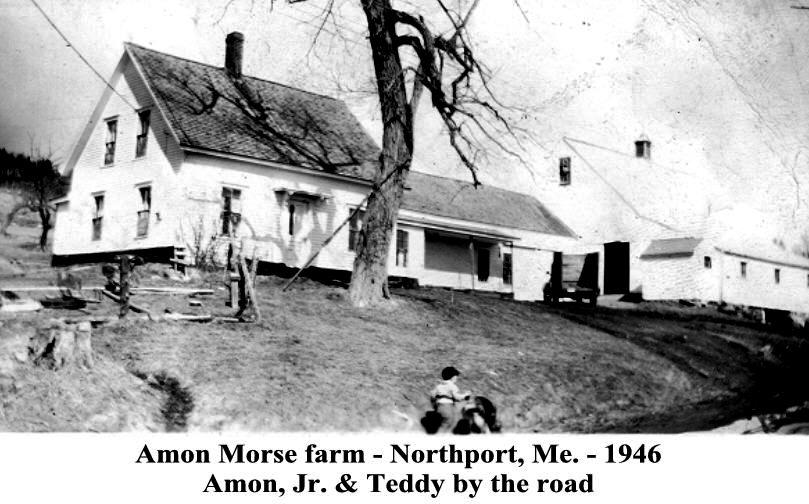 |
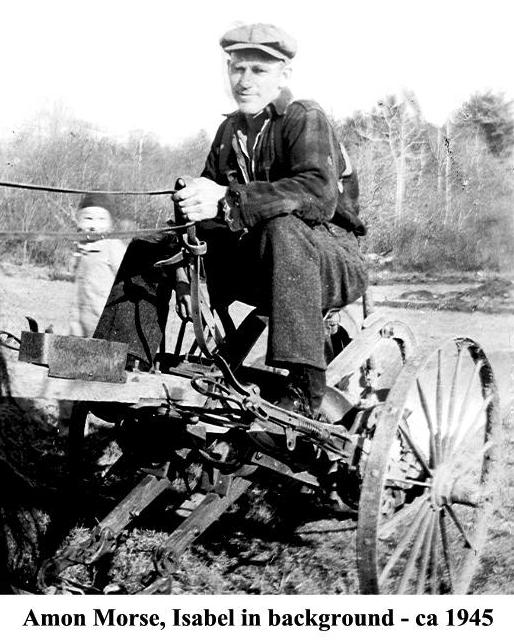 |
The building on the hill
above our farm was throughout my lifetime, and to this day, called The Cheese
Factory. When I was growing up, there were cheese vats and molds in the
decrepit building where we often played. A lilac bush grew in the yard. In the
1881 A Gazetteer of the State of Maine by B.B. Russell of Boston, is
written, “The Northport Cheese factory produces large quantities of cheese that
find ready sale.” The Cheese factory is mentioned in the 1875 Town Register
as being operated by John Hurd. In the 1940’s, my father, Amon Morse, and
Ralph Knight, a noted Northport carpenter and descendant of the early Knights
who settled in Northport by Knight’s Pond, rebuilt the Cheese factory into a
barn, which it is to this day.
|
The building on
the hill above our farm was throughout my lifetime, and to this day,
called The Cheese Factory. When I was growing up, there were cheese
vats and molds in the decrepit building where we often played. A lilac
bush grew in the yard. In the 1881 A Gazetteer of the State of Maine
by B.B. Russell of Boston, is written, “The Northport Cheese factory
produces large quantities of cheese that find ready sale.” The Cheese
factory is mentioned in the 1875 Town Register as being operated
by John Hurd. In the 1940’s, my father, Amon Morse, and Ralph Knight, a
noted Northport carpenter and descendant of the early Knights who
settled in Northport by Knight’s Pond, rebuilt the Cheese factory into a
barn, which it is to this day.
The building on
the hill above our farm was throughout my lifetime, and to this day,
called The Cheese Factory. When I was growing up, there were cheese
vats and molds in the decrepit building where we often played. A lilac
bush grew in the yard. In the 1881 A Gazetteer of the State of Maine
by B.B. Russell of Boston, is written, “The Northport Cheese factory
produces large quantities of cheese that find ready sale.” The Cheese
factory is mentioned in the 1875 Town Register as being operated
by John Hurd. In the 1940’s, my father, Amon Morse, and Ralph Knight, a
noted Northport carpenter and descendant of the early Knights who
settled in Northport by Knight’s Pond, rebuilt the Cheese factory into a
barn, which it is to this day.
|
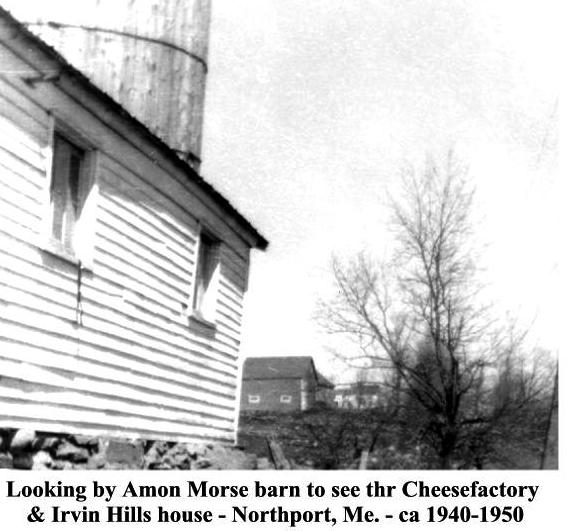 |
Another noted building in
the neighborhood was Brainard School where teacher Edna Woodbury taught for
several years. Later teachers were Annie Dow, and Mrs. Payson. The
Superintendent of Schools was Albert Barnes. Aunt Hazel Dean, who lived across
the road from the school, was janitor, and started the wood fire in the morning.
The windows rattled when the wind blew. The only way to get warm at all in the
winter was to make a circle of desks around the wood-burning stove at the front
of the room. The long stovepipe ran across the room at high ceiling level to
the chimney at the back. Bottles of cocoa, milk or whatever was brought from
home were placed under the stove to prevent them from freezing. There were
segregated ‘rest rooms’, the double-seated toilets at the back of the room, each
with its own door, one for the girls, and one for the boys. There had been a
few wooden knot-holes punched out, probably by curious boys.
  |
|
|
A family of children
living on the Reuben Bird farm on Bird Hill walked the distance to school.
There was no public transportation in those days. The children were so cold
that the teacher made the other children chase them around and around the
stove. It was great fun then, but in hindsight, now realize that the teacher
was saving the children from hypothermia. The teachers in those days had to
make a lot of quick decisions. We walked the mile to school, living the most
distant at the time, up over the hill, with young Isabelle Hills walking with
us, and down by the watering tub. In those days the hill was nearly clear of
trees, and the wind blew down over the hill, making us very cold in the winter.
In coldest times, we stopped at the Willy Hills farm to get warm. Willy Hills
was a brother to Irvin and Milton Hills. The old farmhouse, once belonging to
Mark Wadlin, like ours, had no insulation. They were just getting the fires
started in the morning. They had spring-fed water from the hill that ran into
a tub in the kitchen, and it was as cold as or colder than outside. We were
joined by David and Gene Porter to walk the rest of the way to school, picking
up Varlets and Elisha Hills on the way.
|
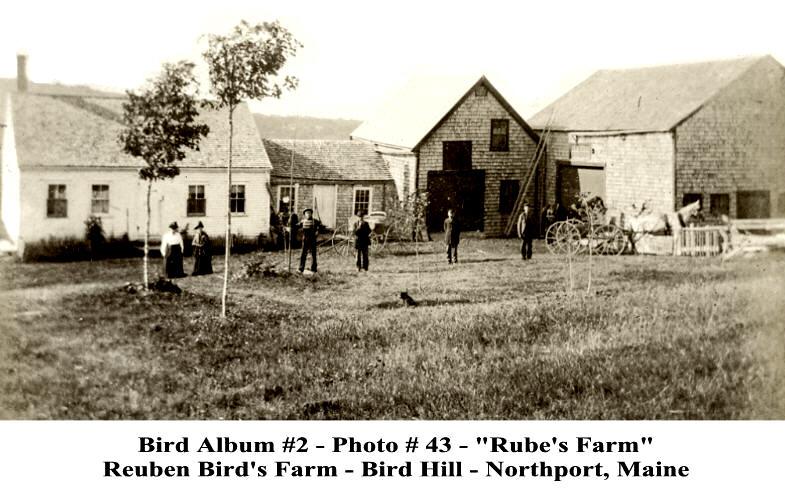 |
The Christmas programs
stand out in my memory. Someone would erect a Christmas tree in the schoolhouse.
The students would make ornaments, probably also having a box of hand-made
ornaments stored in the cloak room. We’d use construction or white paper,
colored with crayons, to make chains and stars for the tree. There may have
been candles, that I don’t remember, but I do recall a bucket of water sitting
under the tree, perhaps because of the wood fire. We would exchange names for
gifts, and the teacher gave each one a gift. It was a magical time for a child.
We would have a Christmas play for our parents, which we all practiced. I
recall one year when I was very young that Mrs. Woodbury had a Christmas party
at her house for the children that she taught, at which time I got a very pretty
crocheted hat. I attended school there until 1946, when it was closed for good.
The Northport Consolidated School was opened near Brown’s Corner, overlooking
the Bay, in the Fall of 1946. We rode a bus from home to Brown’s Corner school.
Once, in our early days, a bus was a converted hearse driven by Henry Trendy.
Nearly across from the
watering tub was Forest Green, who had a large family who had attended Brainard
School, but some of the children were grown, and the younger ones had moved away
in the 1940’s. Across from the Willy Hills’ house was Lorena (Lear) Wind
offer’s small home. Up the road from her house was the small house where Harry
Hills raised his large family. Across from Brainard school was Roscoe Hurd
Dean’s home, the former Brainard farm. The Dean children had attended the
school. When we were there before the school’s closing, Barbara Dean went to
school with us. Beside Brainard School was the Hart road. Irvin Hills had some
logs piled between the Hart road and the school. We played on the logs at
recess time. We also played Hide and Seek, Kick the Can, London Bridge is
Falling Down, Tag, You're It, and games that we thought up. Sometimes we would
walk up the old Hart road to play in a field. Old widowed Mrs. Fletcher lived
across the Hart road. Next, across the road a short way over was Harold and
Martha Tibbett’s. The last building of note was the house at *Greenlaw Corner.
It had been a majestic house in its day, but in my remembrance, no family had
lived in the house for decades until its final torching in 1986. On Halloween
we made our own costumes, once I made an elaborate Witch hat, using an oatmeal
box as the base. We walked the same route as going to school. We had never
heard of Trick or Treat, but we thought that we were scaring the neighbors at
the houses that we stopped at. I recall that Irvin Hills would always manage to
scare us. His beautiful wife, Isabelle, always had a cookie for us. That was
the extent of our 'scaring' the neighbors. This was our little world.
The vocation of the
neighborhood was farming, though we not immune from summer residents. The
Phineas Hurd farm on the Hurd Road to Belmont was sold before World War II to a
family who only came summers. The next farm up the Hurd road was owned by Mason
Stevens, the father of Dr. Carl Stevens. My father bought the Stevens farm from
Dr. Carl after his father’s death, to be resold.
Pitcher Pond had many
summer residents. The fields were cleared which provided a scenic view of the
pond. During the 1940’s when I was growing up, my father leased the Pitcher
fields and barn. He pastured his milking cattle there, and had a gasoline motor
to run his milking machines. The house was then vacant, except for summer
visits. At milking time, twice a day, my father, Mamma, whatever kids were
available, and the dog, Teddy, would go down to the Pitcher barn. While Daddy
and Mamma milked the cows with the milking machine, it was us kids’ duty to test
the electric fence to see if it still had power. If we were doubtful, we would
have to follow the fence around the vast expanse to see if grass or branches
were ‘shorting’ out the wire. My father kept the brush cut and the fences up
yearly.
I remember his anger when
parties from Belfast came out to ski in the field in the winter and cut up his
fence to gain access to the field, which was a natural for winter sports.
Crosby High School held a Winter Carnival there one winter. And then I
remember when Dick L. took a bicycle ride down the length of the field with
Lawrence Foss on the handlebars. Dick jumped off, leaving Lawrence on a wild
ride that nearly scared him to death.
Winters were cold, the
snow was high, sometimes crusty, but great for kids to entertain themselves.
The hill behind our house would be alive with neighborhood kids sliding on a
moonlit night. On the old John Hurd barn where we lived, the roof was long and
sloping down over the ‘tie-up’, with a metal roof. One winter the snow was so
high that you could walk up onto the roof. Dick L. took a precarious ride down
over the metal roof into the snow bank, ripping his trousers as he went. He was
afraid to go home to tell his grandmother of his misfortune.
There was a lot of
activity at Pitcher Pond in all seasons, but we not allowed to go down there.
Vandalism happened there during off-season. My father was convinced that if we
went down there, we would be blamed. Milton Hills had a sawmill down near the
pond, past some of the cottages. We would go down with Daddy to get sawdust for
the cattle’s bedding in the barn. The sawdust pile was high, with layers of
frozen ice and snow, but oh, so much fun to slide down.
The neighborhood was
close-knit, as it probably always had been. We did not realize how poor we all
were, but except for Irvin Hills who lived in the big house at the top of the
hill next to us, we were all poor from the former Recession, but no one had told
us we were poor
The back part of Northport
had no store. We were six miles from Post Office Square in Belfast, and an
equal distance from the stores at Lincolnville Centre. Most of the farms were
self-sufficient, needing a trip to either direction only for staple goods. I
recall at one time a traveling grocery store stopping at our house. We were
fascinated to see shelves of grocery goods in the boxed-style truck body. I
also recall seeing big trucks go by the house, and counting the wheels, as we’d
heard of eight-wheelers.
There was no organized
church in our neighborhood. At one time, revival services were held at Brainard
School. A visiting Bible teacher came to the one-room schoolhouse occasionally,
passing out Gideon New Testaments. The only neighbors who attended church
regularly were the Hills family on the hill. They loaded their car with
neighborhood children to go to churches in Belfast, Morrill, or an occasional
service at Saturday Cove. A Christmas party at the Saturday Cove Church stands
out in my memory. A play was put on with teens and young adults playing the
part of Mary, Joseph, the Wise men, shepherds, and others. They were so
authentically dressed, probably with towels, etc., that I thought that it was
the original scene.
It was a simple life,
probably not much different than when the neighborhood of the ‘Back Settlement
of Northport’ was being settled. It was a good life.
* [The story of the
Greenlaw House is also on the Waldo County website with this story.]
Wonderfully written by

© 2006-2012 All
rights reserved
Isabel Morse Maresh
This page last updated
on November 03, 2012



